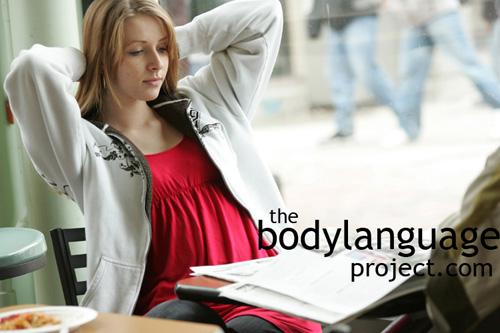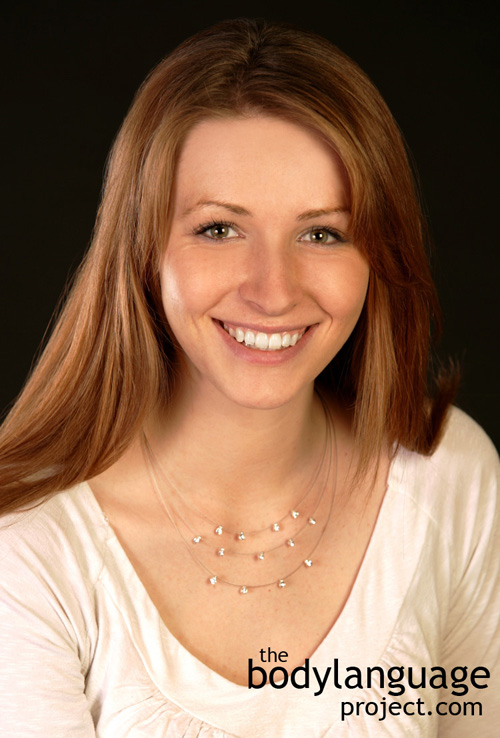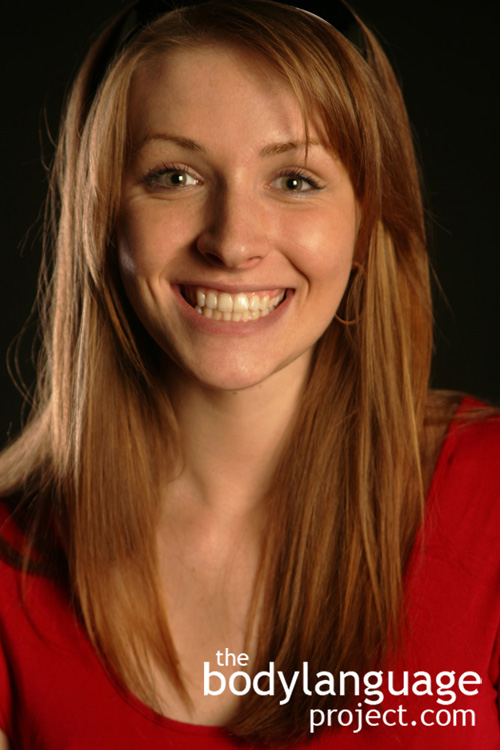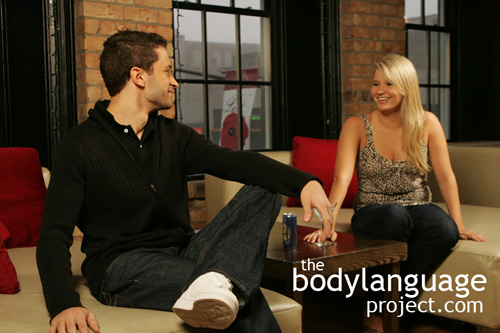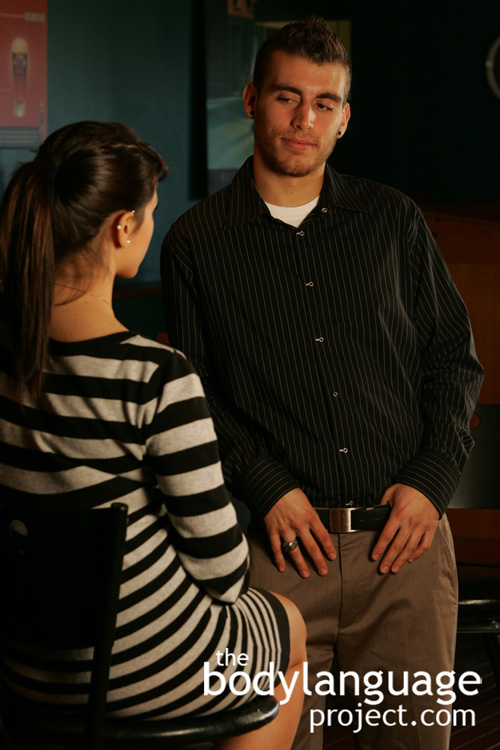Body Language of Hooding or The Catapult
Synonym(s): Full Body Steeple, Catapult (The), Interlaced Hands Behind The Head.
Description: Hooding is a body posture that occurs by placing both hands up and clasped behind the head, elbows back, and chest puffed out while in a seated position. Think of making a hood with your arms and hands.
In One Sentence: Hooding is a posture signaling high dominance.
How To Use it: Use hooding to expand the body and make it appear larger than it is in reality. This will be viewed by others as dominance and confidence therefore it should be reserved for higher ranking individuals who will not be challenged by others.
Bosses, should feel free to assert their dominance with the hooding posture, whereas lower ranking employees should not.
Women should generally not carry the posture due to its high perceived dominance. When done by women it can appear overbearing. If women do choose to do it, they should be expecting to be viewed as capable of backing their dominance with not only verbal counterarguments, but also supportive action. When dominance lacks substance it is viewed in a negative light rather than a positive one.
Context: General.
Verbal Translation: “I’m so dominant and confident that I’m placing my hands on my head where they can’t be used for defense, splaying wide open and taking up a bunch of space and leaning back to be comfortable.”
Variant: See Military Man or Regal Stance and Cowboy Pose Stance for two similarly dominant postures.
Cue In Action: The boss was cocky and confident. When meeting with employees he always placed his hands up behind his head and leaned back in his chair. When the owner of the company showed up and surprised him, he quickly shot forward, took his hands off the back of his head and made a point of shaking hands with him. He didn’t get back to his hooding posture until the owner was safely out of the office.
Meaning and/or Motivation: Hooding or interlaced hands behind the head is an extremely dominant and possibly arrogant, self-satisfied, even threatening display.
The arms behind the head posture shows arrogance because it openly exposes the body to attack through its expansiveness. Dominant people don’t worry about being attacked and often show this confidence by overexposing themselves and their vulnerable areas to challengers.
The full body steeple is common to professionals such as lawyers, accountants, managers, bosses, and others that feel more superior then their counterparts.
Hooding can be used to intimidate others, or convey a relaxed, cocky disposition, but as always, body language needs to be taken in context. The accompanying dialogue will help tell us what is really going on.
Professionals, such as lawyers, accountants, managers, bosses, and others that tend to take their superiority to higher levels than the rest of us, will be seen using the full body steeple. This is the hooding posture coupled with a figure four leg cross and leaning back in the chair.
Cue Cluster: When seated hooding is coupled with body leaning backward with the legs spread wide open we have a very dominant crotch display. The postures is completed by combining it with the figure-four-leg cross which happens by placing the ankle of the opposite foot across the knee.
Body Language Category: Arrogance or arrogant body language, Aggressive body language, Authoritative body language, Confident body language, Dominant body language, Expansive movements, Gravity defying body language, High confidence body language, Open body language.
Resources:
Allen, Jill; Sarah J. Gervais and Jessi L. Smith. Sit Big to Eat Big: The Interaction of Body Posture and Body Concern on Restrained Eating. Psychology of Women Quarterly 2013. 37(3): 325-336. DOI: 10.1177/0361684313476477pwq.sagepub.com
http://bodylanguageproject.com/articles/sit-big-to-eat-big-how-constrictive-postures-reduce-food-consumption/
Arnette, S. L., & Pettijohn, T. F., II. (2012). The effects of posture on self-perceived leadership. International Journal of Business and Social Science, 3, 8–13.
Bohns, Vanessa K. and Scott S. Wiltermuth. It Hurts When I Do This (Or You Do That): Posture And Pain tolerance. Journal of Experimental Social Psychology. 2012. 48: 341-345.
http://bodylanguageproject.com/articles/dominant-and-submissive-postures-affects-more-than-public-perception-it-also-affects-felt-pain-and-physical-strength/
Briñol, P., Petty, R. E., & Wagner, B. (2009). Body posture effects on self-evaluation: A self-validation approach. European Journal of Social Psychology, 39, 1053–1064.
Bartholomewn, Morgan E.; Sheri L. Johnson. Nonverbal Dominance Behavior Among Individuals at Risk for Mania. Journal of Affective Disorders. 2014. 159: 133-138.
Carney, Dana R.; Amy J.C. Cuddy; Andy J. Yap. Power Posing: Brief Nonverbal Displays Affect Neuroendocrine Levels and Risk Tolerance. Psychological Science, 2010; 21 (10): 1363-1368.
http://bodylanguageproject.com/articles/benefits-power-posing-high-stakes-performance/
Cuddy, Amy J.C., Caroline A. Wilmuth, and Dana R. Carney. The Benefit of Power Posing Before a High-Stakes Social Evaluation. Harvard Business School Working Paper, No. 13-027, September 2012.
http://bodylanguageproject.com/articles/benefits-power-posing-high-stakes-performance/
Cashdan, Elizabeth. Smiles, Speech, and Body Posture: How Women and Men Display Sociometric Status and Power. Journal of Nonverbal Behavior. 1998. 22(4): 209-228.
Cesario, J., & McDonald, M. M. (2013). Bodies in context: Power poses as a computation of action possibility. Social Cognition, 31, 260–274.
de Lemus, Soledad; Russell Spears and and Miguel Moya. The Power of a Smile to Move You: Complementary Submissiveness in Women’s Posture as a Function of Gender Salience and Facial Expression. Personality and Social Psychology Bulletin. 2012. 38(11): 1480-1494.
Fischer, Julia; Peter Fischer; Birte Englich; Nilüfer Aydin and Dieter Frey. Empower My Decisions: The Effects of Power Gestures on Confirmatory Information Processing. Journal of Experimental Social Psychology. 2011. 47: 1146-1154.
http://bodylanguageproject.com/articles/downside-power-posing-body-language-looking-power-posing-action-study/?preview=true
Gorkan Ahmetoglu, Viren Swami. Do Women Prefer “Nice Guys?” The Effect Of Male Dominance Behavior On Women’s Ratings. Social Behavior And Personality, 2012; 40(4), 667-672.
http://bodylanguageproject.com/articles/how-to-significantly-increase-male-attractiveness-with-simple-body-language-nice-guys-finish-last-once-again/
Huang, L., Galinsky, A. D., Gruenfeld, D. H., & Guillory, L. E. (2011). Powerful postures versus powerful roles: Which is the proximate correlate of thought and behavior? Psychological Science, 22, 95–102.
Locke, Connson C. and Cameron Anderson. The Downside of Looking Like a Leader: Leader’s Powerful Demeanor Stifles Follower Voice in Participative Decision-Making.. Academy of Management Annual Meeting Proceedings. 2010. 8(1): 1-6.
http://bodylanguageproject.com/articles/power-body-language-goes-far/
Laird, J. D., & Lacasse, K. (2014). Bodily influences on emotional feelings: Accumulating evidence and extensions of William James’s theory of emotion. Emotion Review, 6, 27–34.
Lee, E. H., & Schnall, S. (2014). The influence of social power on weight perception. Journal of Experimental Psychology: General, 143, 1719–1725.
Michalak, J., Mischnat, J., & Teismann, T. (2014). Sitting posture makes a difference: Embodiment effects on depressive memory bias. Clinical Psychology & Psychotherapy, 21, 519–524.
Minvaleev, R. S., Nozdrachev, A. D., Kir’yanova, V. V., & Ivanov, A. I. (2004). Postural influences on the hormone level in healthy subjects: I. The cobra posture and steroid hormones. Human Physiology, 30, 452–456.
Marsh, Abigail A; Henry H. Yu; Julia C. Schechter and R. J. R. Blair. Larger than Life: Humans’ Nonverbal Status Cues Alter Perceived Size. PLoS ONE. 2009. 4(5): e5707. doi:10.1371/journal.pone.0005707. http://bodylanguageproject.com/articles/large-life-nonverbal-dominance-affects-perception-size/?preview=true
Roberts, Tomi-Ann and Yousef Arefi-Afshar. Not All Who Stand Tall Are Proud: Gender Differences in the Proprioceptive Effects of Upright Posture. Cognition and Emtion. 2007. 21(4):714-727.
Navarro, Joe. 2008. What Every BODY is Saying: An Ex-FBI Agent’s Guide to Speed-Reading People. William Morrow Paperbacks.
Nair, S., Sagar, M., Sollers, J., III, Consedine, N., & Broadbent, E. (2014). Do slumped and upright postures affect stress responses? A randomized trial. Health Psychology. Advance online publication. doi:10.1037/hea0000146
Park, Lora E.; Lindsey Streamer; Li Huang and Adam D. Galinsky. Stand Tall, But Don’t Put Your Feet Up: Universal and Culturally-Specific Effects of Expansive Postures On Power. Journal of Experimental Social Psychology. 2013; 49: 965–971.
http://bodylanguageproject.com/articles/are-expansive-postures-of-power-universal-or-cultural/
Pease, Barbara and Allan Pease. 2006. The Definitive Book of Body Language Hardcover. Bantam.
Ranehill, Eva; Anna Dreber; Magnus Johannesson; Susanne Leiberg; Sunhae Sul and Roberto A. Weber. Assessing the Robustness of Power Posing: No Effect on Hormones and Risk Tolerance in a Large Sample of Men and Women. Psychological Science, March, 2015. doi: 10.1177/0956797614553946
http://pss.sagepub.com/content/early/2015/03/30/0956797614553946.full.pdf
http://bodylanguageproject.com/articles/power-posing-no-effect-hormones-amy-cuddy-wrong/
Riskind, J. H. (1984). They stoop to conquer: Guiding and selfregulatory functions of physical posture after success and failure. Journal of Personality and Social Psychology, 47, 479–493.
Riskind, J. H., & Gotay, C. C. (1982). Physical posture: Could it have regulatory or feedback effects on motivation and emotion? Motivation and Emotion, 6, 273–298.
Roberts, Tomi-Ann and Yousef Arefi-Afshar. Not All Who Stand Tall Are Proud: Gender Differences in the Proprioceptive Effects of Upright Posture. Cognition and Emtion. 2007. 21(4):714-727.
http://bodylanguageproject.com/articles/do-women-benefit-from-power-posing-study-suggests-not/
Stepper, S., & Strack, F. (1993). Proprioceptive determinants of emotional and nonemotional feelings. Journal of Personality and Social Psychology, 64, 211–220.
Strelan, P., Weick, M., & Vasiljevic, M. (2013). Power and revenge. British Journal of Social Psychology, 53, 521–540.
Sturman, Edward D. Invluntary Subordination and Its Relation to Personality, Mood,
and Submissive Behavior. Psychological Assessment. 2011. 23(1): 262-276 DOI: 10.1037/a0021499
http://bodylanguageproject.com/articles/nonverbal-submission-men-women-depression-critical-examination-use-disuse-submission/
Stanton, Steven J. and Robin S. Edelstein. The Physiology of Women’s Power Motive: Implicit Power Motivation is Positively Associated With Estradiol Levels in Women. Journal of Research in Personality. 2009. 43: 1109-1113.
http://bodylanguageproject.com/articles/the-estrogen-factor-the-search-for-nonverbal-power-in-women/
Stanton, Steven J. The Essential Implications of Gender in Human Behavioral Endocrinology Studies. Frontiers in Behavioral Neuroscience. 2011. 5(9): 1-3. doi: 10.3389/fnbeh.2011.00009
http://bodylanguageproject.com/articles/a-critical-commentary-on-amy-cuddys-power-posing/
Tiedens, Larissa Z. and Alison R. Fragale. Power Moves: Complementarity in Dominant and Submissive Nonverbal Behavior. Journal of Personality and Social Psychology. 2003, 84(3): 558–568.
http://bodylanguageproject.com/articles/power-posing-no-effect-hormones-amy-cuddy-wrong/
Welker, K. M., Oberleitner, D. E., Cain, S., & Carré, J. M. (2013). Upright and left out: Posture moderates the effects of social exclusion on mood and threats to basic needs. European Journal of Social Psychology, 43, 355–361.
Yap, Andy J. Abbie S. Wazlawek, Brian J. Lucas, Amy J. C. Cuddy, Dana R. Carney. The Ergonomics of Dishonesty: The Effect of Incidental Posture on Stealing, Cheating, and Traffic Violations, 24(11); 2281-2289.
http://bodylanguageproject.com/articles/body-posture-physical-environment-determine-feelings-and-behaviour-study/

